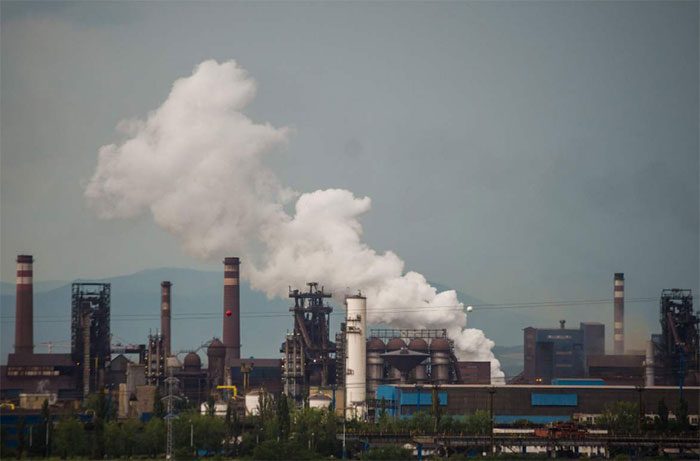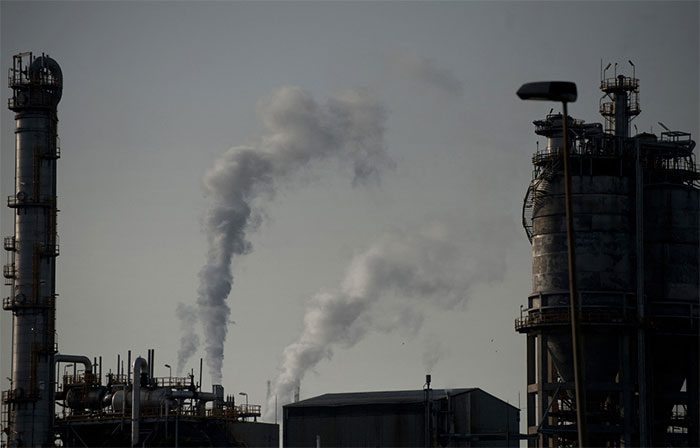The Guardian’s investigation reveals that 98% of Europeans are breathing harmful, polluted air, which is linked to 400,000 deaths annually.
According to the study, Europe is facing a severe public health crisis as almost everyone across the continent lives in areas with dangerous levels of air pollution.
Specifically, data analysis indicates that up to 98% of the population resides in areas where the concentration of fine particulate matter PM2.5 exceeds the World Health Organization (WHO) guidelines.

Smoke rising from a factory in Kosice, Eastern Slovakia, on July 29, 2019. (Photo: AFP/TTXVN)
The country most severely affected in Europe is North Macedonia. Nearly two-thirds of the population live in areas with PM2.5 levels exceeding WHO standards by four times. Four regions in the country have air pollution levels nearly six times higher, including the capital city of Skopje.
Air quality in Eastern Europe is significantly worse than in Western Europe. Most people in seven Eastern European countries, including Serbia, Romania, Albania, North Macedonia, Poland, Slovakia, and Hungary, experience fine particulate pollution double the WHO guidelines. More than half of the population in North Macedonia and Serbia lives in environments that are four times more toxic than WHO standards.
In Germany, three-quarters of the population breathe air that is twice as polluted as WHO levels. In Spain, this figure is 49%, and in France, it is 37%.
In the UK, three-quarters of the population lives in areas with pollution levels 1 to 2 times higher than WHO guidelines, with nearly a quarter of the population facing pollution levels more than double that limit.
Nearly 30 million Europeans are living in areas with fine particulate concentrations at least four times higher than the WHO’s threshold.
In contrast, in Sweden, there are no areas where PM2.5 pollution levels exceed double the WHO figure. Some regions in northern Scotland are among the few areas across Europe that fall below this level.
For this study, The Guardian collaborated with pollution experts to create an interactive map showing the most heavily polluted areas in Europe. WHO’s current regulations state that the annual average concentration of PM2.5 should not exceed 5 µg/m3. The new analysis shows that only 2% of the European population lives in areas within this limit. Experts indicate that PM2.5 pollution causes approximately 400,000 deaths annually throughout Europe.
Roel Vermeulen, Professor of Environmental Epidemiology at Utrecht University, commented: “This is a serious public health crisis. What we see quite clearly is that almost everyone in Europe is breathing unhealthy air.”
Traffic, industry, heating, and agriculture are major sources of PM2.5 fine particles, and air pollution predominantly affects the poorest areas.
Air pollution has become a significant issue in Europe, prompting the European Union (EU) to face pressure for increased action to address the growing public health crisis. Last week, the European Parliament voted to adopt the WHO’s PM2.5 regulations by 2035. This law will impose legally binding limits on annual PM2.5 concentrations at 5 µg/m3, down from the current level of 25 µg/m3. However, experts argue that urgent action is needed now.

Emissions rising from a chemical industrial area in Algeciras, Spain. (Photo: AFP/TTXVN).
There is increasing evidence that air pollution affects almost all organs in the body and is linked to a range of health issues such as heart disease, lung disease, cancer, diabetes, depression, mental illness, cognitive decline, and low birth weight.
A recent study shows that air pollution is responsible for 1 million stillbirths each year. Another study found that the hearts of young people living in cities have absorbed billions of particles from polluted air.
Dr. Hanna Boogaard, an air pollution expert in Europe, stated that this new analysis is crucial in providing information about air pollution and its impact in Europe. According to her, hundreds of thousands of deaths occur annually due to air pollution. She remarked: “These deaths are preventable, and the estimated figure does not include millions of cases of non-fatal diseases.”
Some towns and cities across Europe are making progress in addressing air pollution, from establishing ultra-low emissions zones to traffic reduction plans and initiatives for walking and cycling. However, experts assert that politicians must take more urgent action in light of increasing evidence of harm.
The study also indicates that in countries, poorer communities often live in the areas with the worst air pollution. Barbara Hoffmann, Professor of Environmental Epidemiology at the University of Düsseldorf, stated that air pollution is an environmental justice issue: “The countries most heavily affected are also those with the lowest average incomes… Cleaning the air, especially in Eastern Europe, is essential to provide equal opportunities for healthy living across Europe.”


















































